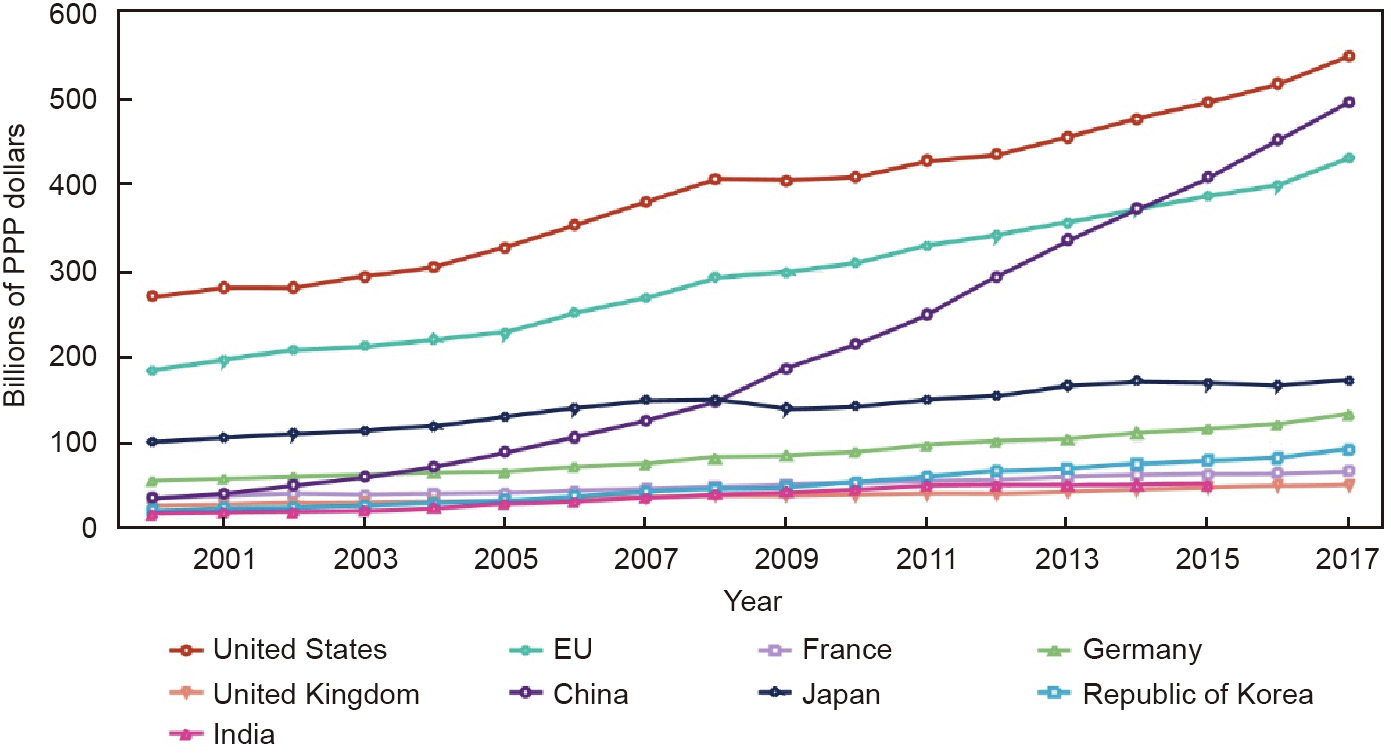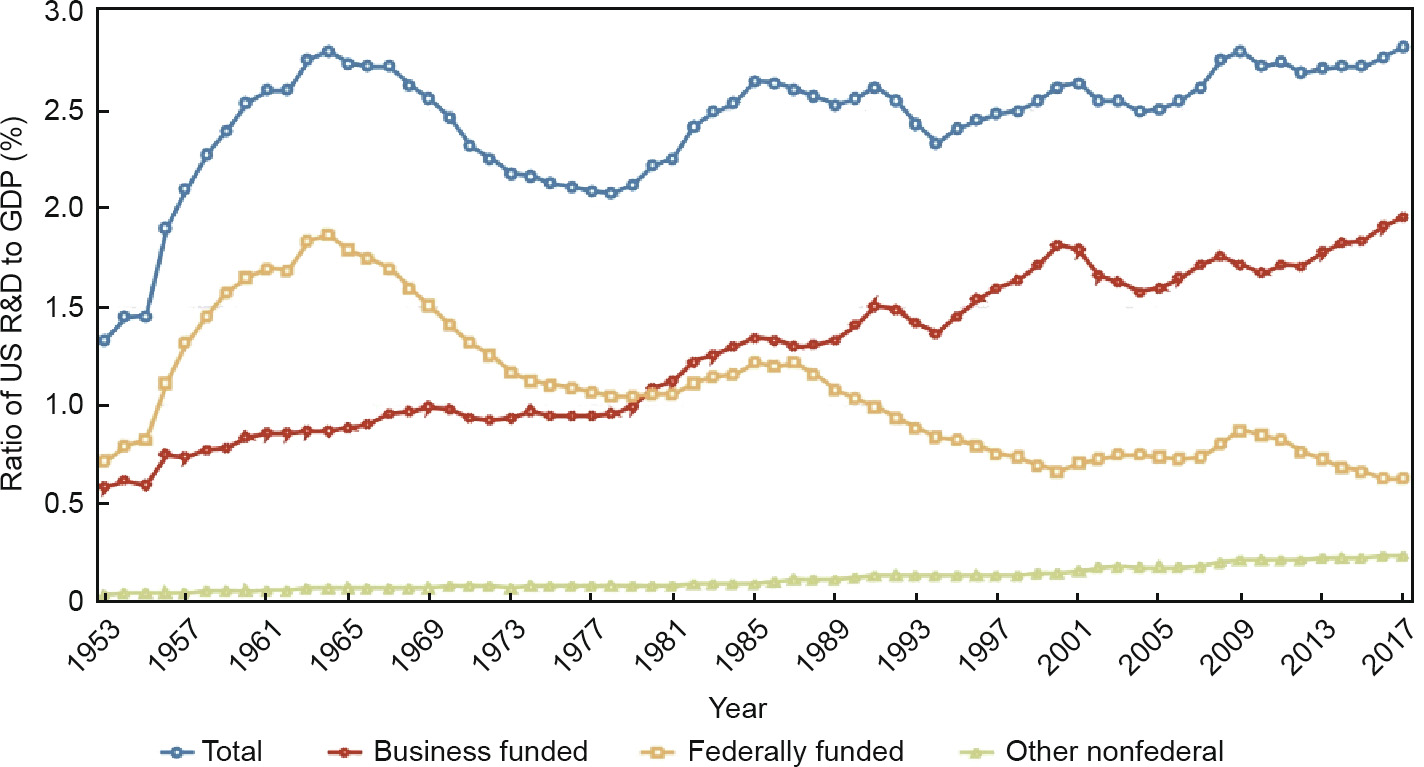In January 2020, the US National Science Board released its biennial report on the state of science and engineering (S&E) research in the United States and the world [1]. The overall health of science has never been better: According to the report, the worldwide amount of funding for research and development (R&D) has tripled since 2000. “The whole world is realizing the importance of developing new knowledge to grow economic prosperity,” said Diane Souvaine, chair of the National Science Board and professor of computer science and mathematics at Tufts University in Medford, MA, USA.
According to the report, China and other Asian nations and regions have made great strides in the past 20 years. By 2017, the last year for which data were available, China’s annual investment in R&D had very nearly caught up with that of the United States (Fig. 1) [1]. Unofficially, in the two years since then, China’s annual R&D investment has almost certainly passed the United States [2]. The two nations combined account for 48% of the world’s R&D spending.
《Fig. 1》

Fig. 1. Gross domestic expenditures on R&D, by selected region, country, or economy from 2000 to 2017. The United States and China lead the world in gross domestic spending (USD) on R&D, with China nearly catching up to the United States by 2017. China and the Republic of Korea had particularly strong gains between 2000 and 2017. EU: European Union; PPP: purchasing power parity. Notes: Data are for the top eight R&D-performing countries and the EU. Data are not available for all countries for all years. The EU includes France, Germany, and the United Kingdom. Data for the United States in this figure reflect international standards for calculating gross expenditures on R&D, which vary slightly from the National Center for Science and Engineering Statistics (NCSES) protocol for tallying US total R&D. Sources: NCSES, National Patterns of R&D Resources; Organization for Economic Co-operation and Development (OECD), Main Science and Technology Indicators 2019/1; United Nations Educational, Scientific and Cultural Organization (UNESCO) Institute for Statistics, Research and Experimental Development data set [1]. Credit: US National Science Foundation.
However, it would be inappropriate to portray science globally as a race between the United States and China. Scientific research is “not a zero-sum game,” said Souvaine. Research dollars spent in one nation benefit not only that nation, but—provided information is shared openly—others around the world.
The United States and China face very different situations as they move into the 2020s. In the United States, the “intensity” of research—that is, the amount of research spending as a percentage of the gross domestic product (GDP)—has remained relatively steady over the years (Fig. 2) [3]. However, the source and distribution of that funding has changed dramatically [3]. In the 1960s, the federal government was the largest sponsor of research. Now, it funds only 22%. This reduction has been compensated by increased funding from business. However, the two sources have very different priorities. “Business research is concentrated in certain industries, such as computers, aerospace, and pharmaceuticals,” Souvaine said. ‘‘Only the federal government can create a strategic long-term commitment to the entire research enterprise.” That commitment has been maintained over the years in inflationadjusted dollars while GDP has increased more rapidly. How closely the federal R&D commitment should follow rising GDP remains the subject of continuing political debate [4].
《Fig. 2》

Fig. 2. Ratio of US R&D to GDP, by roles of federal, business, and other nonfederal funding for R&D from 1953 to 2017. In the United States, R&D spending as a percentage of GDP peaked in 1964 but then surpassed that peak for the first time in 2017. The funding sources have changed dramatically, with business (red) now accounting for much more than government (yellow), and with nonprofit sources (green), primarily universities and foundations, beginning to make a significant impact. Notes: Data for 2017 are preliminary and may later be revised. The federally funded data represent the federal government as a funder of R&D by all performers and similar for the business-funded data, The other nonfederal category includes R&D funded by all other sources—mainly, higher education, nonfederal government, and other nonprofit organizations. The GDP data used reflect the US Bureau of Economic Analysis’s comprehensive revisions of the national income and product accounts of July 2018 and the annual update of July 2019. Sources: NCSES, National Science Foundation, National Patterns of R&D Resources (annual series) [3]. Credit: US National Science Foundation.
Less obviously, universities and nonprofit foundations have ramped up their support for science (see lower curve in Fig. 2). This is predominantly for basic research—that is, research done without a specific commercial application in view. In the United States, 17% of funded research is basic, versus only 6% in China [1]. (Some other Western countries are even higher, such as France with 21%.) “The funding of basic research which has no application is one of the best investments the United States has made,” said John Hopcroft, professor of engineering and applied mathematics at Cornell University in Ithaca, NY, USA, Turing Prize winner (1986), and a frequent consultant to China on education issues [5]. “Basic research goes off in all kinds of directions and mostly has no impact,” Hopcroft said. “But occasionally someone does something that creates a whole new discipline, millions of jobs, and adds billions to our gross domestic product.”
Hopcroft gives credit to China for fueling its science boom with a huge investment in education (Fig. 3) [1]. “China realizes that there is an information revolution going on. In the past, energy and material resources were what made powerful nations,” he said. “In the future, they believe energy and material resources will be available to all nations, and it will be talent that makes the truly great nations.”
《Fig. 3》

Fig. 3. First university degrees in S&E, by selected region, country, or economy from 2000 to 2016. Beginning in 2002, undergraduate degrees in science awarded in China surged dramatically, and China now leads the world by a wide margin. EU top 6: France, Germany, Italy, Poland, Spain, and the United Kingdom. Notes: Data are not available for all regions, countries, or economies for all years. To facilitate international comparison, data for the United States are those reported to the OECD, which vary slightly from the NCSES classification of fields presented in other sections of the report. The EU top 6 total includes aggregated data for the six EU countries producing the highest number of S&E first university degrees in 2016: France, Germany, Italy, Poland, Spain, and the United Kingdom. The data source for Japan changed in 2014, which may potentially result in a time series break. Sources: OECD, Education and Training Indicators, 2019; Eurostat, education and training database; Ministry of Education, Culture, Sports, Science and Technology (Japan), Survey of Education (various years); National Bureau of Statistics (China), China Statistical Yearbook (various years); Taiwan’s education authority, Educational Statistics (Taiwan region, China) (various years) [1]. Credit: US National Science Foundation.
But in some ways, Hopcroft said, the Chinese educational system may hold back its young talent. “One thing is that China focuses on objective measures,” such as funding and number of publications, he said. “Education is so complex that an objective measure will not capture its true quality.” Some symptoms of the potential problem: Chinese university departments have quotas for the number of students, which means the students cannot “vote with their feet” to train in the most exciting areas. Junior faculty members are required to work for senior faculty instead of generating their own innovative ideas. Academic departments are still under much pressure to do experimental development (the “D” in “R&D”), meaning less attention to both education and basic research [5,6].
Perhaps for these reasons, the National Statistics Board report finds that the number of Chinese graduate students in the United States has grown even over the last three years [7]. Suggesting that many are finding career opportunities in the United States, 85% of Chinese graduate students remain in the United States for at least five years after earning their doctorates [1]. America clearly remains a strong contender for “internationally mobile” talentand benefits from having them at the start of their careers. Therefore, Souvaine said, “the United States needs to do everything in its power to keep the research environment open and welcoming to international students, while doing more to develop domestic talent. We should not try to outshine China. We need to be the best version of ourselves.”













 京公网安备 11010502051620号
京公网安备 11010502051620号




